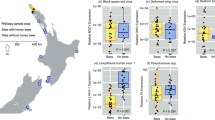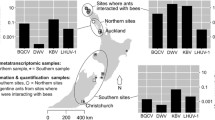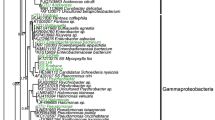Abstract
Thriving populations of invasive species often decline, but the mechanisms behind such declines are rarely elucidated. The microbial community living within insects can have significant impacts on host health and population dynamics and may be one such mechanism. Here, we use Illumina RNAseq and 16S amplicon sequencing to compare the bacterial communities, and investigate the presence of viruses, in queens of the invasive yellow crazy ant, Anoplolepis gracilipes, from populations in various stages of decline or expansion in Australia. Black queen cell virus and sequences with homology to the Dicistroviridae family of viruses were detected in queens from declining ant populations. This is the first instance of sequences with homology to a virus being found in A. gracilipes and may indicate a new virus. The overall bacterial communities were not statistically different between the population types and a number of potential mutualists were discovered. Several putative pathogens were also detected, including Candidatus Rhabdochlamydia, the entomopathogen Serratia marcescens and the reproductive parasite Candidatus Cardinium. These taxa are known to significantly affect host biology in other organisms. Our survey has identified several candidates that may be responsible for population declines of this invasive ant, and therefore may have potential as biological control agents.





Similar content being viewed by others

References
Andrews S (2015) FastQC v 0.11.3 Babraham Bioinformatics. http://www.bioinformatics.bbsrc.ac.uk/projects/fastqc/
Arif B, Escasa S, Pavlik L (2011) Biology and genomics of viruses within the genus Gammabaculovirus. Viruses 3:2214–2222
Bartram A, Lynch M, Stearns J, Moreno-Hagelsieb G, Neufeld J (2011) Generation of multimillion-sequence 16S rRNA gene libraries from complex microbial communities by assembling paired-end Illumina reads. Appl Environ Microb 77(11):3846–3852
Bokulich N, Subramanian S, Faith J, Gevers D, Gordon J, Knight R, Mills D, Caporaso G (2013) Quality-filtering vastly improves diversity estimates from Illumina amplicon sequencing. Nat Methods 10(1):57–59
Briano J (2005) Long-term studies of the red imported fire ant, Solenopsis invicta, infected with the microsporidia Vairimorpha invictae and Thelohania solenopsae in Argentina. Environ Entomol 34(1):124–132
Camacho C, Madden T, Ma N, Tao T, Agarwala R, Morgulis A (2008) BLAST® command line applications user manual. National Center for Biotechnology Information, Bethesda
Cameron S, Lozier J, Strange J, Koch J, Cordes N, Solter L, Griswold T (2011) Patterns of widespread decline in North American bumble bees. PNAS 108(2):662–667
Cannon R (1993) Prospects and progress for Bacillus thuringiensis based pesticides. Pest Manag Sci 37:331–335
Caporaso J, Lauber C, Walters W, Berg-Lyons D, Huntley J, Fierer N, Owens S, Betley J, Fraser L, Bauer M, Gormley N, Gilbert J, Smith G, Knight R (2012) Ultra-high-throughput microbial community analysis on the Illumina HiSeq and MiSeq platforms. ISME J 6:1621–1624
Chantawannakul P, Ward L, Boonham N, Brown M (2006) A scientific note on the detection of honeybee viruses using real-time PCR (TaqMan) in Varroa mites collected from a Thai honeybee (Apis mellifera) apiary. J Invertebr Pathol 91:69–73
Clarke K (1993) Non-parametric multivariate analyses of changes in community structure. Aust Ecol 18:117–143
Clarke K, Gorley R (2006) PRIMER v 6.1.11: User manual and tutorial. PRIMER-E, Plymouth
Cooling M (2016) Population dynamics and pathogens of the invasive yellow crazy ant (Anoplolepis gracilipes) in Arnhem Land, Australia. Dissertation, Victoria University of Wellington
Cooling M, Hoffmann B (2015) Here today, gone tomorrow: declines and local extinctions of invasive ant populations in the absence of intervention. Biol Invasions 17:3351–3357
Corsaro D, Thomas V, Goy G, Venditti D, Radek R, Greub G (2007) ‘Candidatus Rhabdochlamydia crassificans’, an intracellular bacterial pathogen of the cockroach Blatta orientalis (Insecta: Blattodea). Syst Appl Microbiol 30:221–228
Cox M, Peterson D, Biggs P (2010) SolexaQA: at-a-glance quality assessment of Illumina second-generation sequencing data. BMC Bioinform 11:485
Cox-Foster D, Conlan S, Holmes E, Palacios G, Evans J, Moran N, Quan P, Briese T, Hornig M, Geiser D, Martinson V, vanEngelsdorp D, Kalkstein A, Drysdale A, Hui J, Zhai J, Cui L, Hutchison S, Simons J, Egholm M, Pettis J, Lipkin W (2007) A metagenomic survey of microbes in honey bee colony collapse disorder. Science 318:283–287
Crotti E, Rizzi Chouaia B, Ricci I, Favia G, Alma A, Sacchi L, Bourtzis K, Mandrioli M, Cherif A, Bandi C, Daffonchio D (2010) Acetic acid bacteria, newly emerging symbionts of insects. Appl Environ Microb 76(21):6963–6970
de Miranda J, Cordoni G, Budge G (2010) The acute bee paralysis virus-Kashmir bee virus-Israeli acute paralysis virus complex. J Invertebr Pathol 103:S30–S47
Edgar R (2010) Search and clustering orders of magnitude faster than BLAST. Bioinformatics 26(19):2460–2461
Evans J, Schwarz R (2011) Bees brought to their knees: microbes affecting honey bee health. Trends Microbiol 19(12):614–620
Feldhaar H (2011) Bacterial symbionts as mediators of ecologically important traits of insect hosts. Ecol Entomol 36:533–543
Grabherr M, Haas B, Yassour M, Levin J, Thompson D et al (2013) Trinity: reconstructing a full-length transcriptome without a genome from RNA-Seq data. Nat Biotechnol 26(7):644–652
Gruber M (2012) Genetic factors associated with variation in abundance of the invasive yellow crazy ant (Anoplolepis gracilipes). Dissertation, Victoria University of Wellington
Gruber M, Burne A, Abbott K, Pierce R, Lester P (2012) Population decline but increased distribution of an invasive ant genotype on a Pacific atoll. Biol Invasions 15(3):599–612
Haines I, Haines J, Cherrett J (1994) The impact and control of the Crazy ant, Anoplolepis longipes (Jerd.), in the Seychelles. In: Williams D (ed) Exotic ants: biology, impact, and control of introduced species. Westview Press, Boulder, pp 206–218
He H, Chen Y, Zhang Y, Wei C (2011) Bacteria associated with gut lumen of Camponotus japonicus. Environ Entomol 40(6):1405–1409
Hoffmann B (2015) Integrating biology into invasive species management is a key principle for eradication success: the case of yellow crazy ant Anoplolepis gracilipes in northern Australia. Bull Entomol Res 105:141–151
Holway D, Lach L, Suarez A, Tsutsui N, Case T (2002) The causes and consequences of ant invasions. Annu Rev Ecol Evol Syst 33:181–233
Hunter M, Perlman S, Kelly S (2003) A bacterial symbiont in the Bacteroidetes induces cytoplasmic incompatibility in the parasitoid wasp Encarsia pergandiella. Proc R Soc B 270:2185–2190
Huson D, Mitra S, Ruscheweyh H, Weber N, Schuster S (2011) Integrative analysis of environmental sequences using MEGAN4. Genome Res 21(9):1552–1560
Ishak H, Plowes R, Sen R, Kellner K, Meyer E, Estrada D, Dowd S, Mueller U (2011a) Bacterial diversity in Solenopsis invicta and Solenopsis geminata ant colonies characterized by 16S amplicon 454 pyrosequencing. Microb Ecol 61:821–831
Ishak H, Miller J, Sen R, Dowd S, Meyer E, Mueller U (2011b) Microbiomes of ant castes implicate new microbial roles in the fungus-growing ant Trachymyrmex septentrionalis. Sci Rep 1:204
Johansson H, Dhaygude K, Lindstrom S, Helantera H, Sundstrom L, Trontti K (2013) A metatranscriptomic approach to the identification of microbiota associated with the ant Formica exsecta. PLoS One 8(11):e79777
Lach L, Hoffmann B (2011) Are invasive ants better plant-defense mutualists? A comparison of foliage patrolling and herbivory in sites with invasive yellow crazy ants and native weaver ants. Oikos 120:9–16
Larkin M, Blackshields G, Brown N, Chenna R, McGettigan PA et al (2007) ClustalW and ClustalX version 2. Bioinformatics 23:2947–2948
Lauzon C, Bussert T, Sjogren R, Prokopy R (2003) Serratia marcescens as a bacterial pathogen of Rhagoletis pomonella flies (Diptera: Tephritidae). Eur J Entomol 100:87–92
Lester P, Gruber M (2016) Booms, busts and population collapses in invasive ants. Biol Invasions. doi:10.1007/s10530-016-1214-2
Liu S, Vijayendran D, Bonning B (2011) Next generation sequencing technologies for insect virus discovery. Viruses 3:1849–1869
Majer J (1984) Recolonisation by ants in rehabilitated open-cut mines in Northern Australia. Reclam Reveg Res 2:279–298
Martin S, Highfield A, Brettell L, Villalobos E, Budge G, Powell M, Nikaido S, Schroeder D (2012) Global honey bee viral landscape altered by a parasitic mite. Science 336:1304–1306
Masella A, Bartram A, Truszkowski J, Brown D, Neufeld J (2012) PANDAseq: paired-end assembler for Illumina sequences. BMC Bioinform 13:31
McDonald D, Price M, Goodrich J, Nawrocki E, DeSantis T, Probst A, Andersen G, Knight R, Hugenholtz P (2012) An improved Greengenes taxonomy with explicit ranks for ecological and evolutionary analyses of bacteria and archaea. ISME J 6(3):610–618
Paulson A, von Aderkas P, Perlman S (2014) Bacterial associates of seed-parasitic wasps (Hymenoptera: Megastigmus). BMC Microbiol 14:224
Porter S, Valles S, Oi D (2013) Host specificity and colony impacts of the fire ant pathogen, Solenopsis invicta virus 3. J Invertebr Pathol 114:1–6
Rice W (1989) Analyzing tables of statistical tests. Evolution 43:223–225
Robertson C (2003) Spectrophotometry’s next generation technology. American Biotechnology Laboratory
Rokop Z, Horton M, Newton I (2015) Interactions between co-occurring lactic acid bacteria in the honey bee hive. Appl Environ Entomol. doi:10.1128/AEM.01259-15AEM.01259-15
Rose E, Harris R, Glare T (1999) Possible pathogens of social wasps (Hymenoptera: Vespidae) and their potential as biological control agents. N Z J Zool 26:179–190
Russell J (2012) The ants (Hymenoptera: Formicidae) are unique and enigmatic hosts of prevalent Wolbachia (Alphaproteobacteria) symbionts. Myrmecol News 16:7–23
Russell J, Moreau C, Goldman-Huertas B, Fujiwara M, Lohman D, Pierce N (2009) Bacterial gut symbionts are tightly linked with the evolution of herbivory in ants. PNAS 106(50):21236–21241
Russell J, Funaro C, Giraldo Y, Goldman-Huertas B, Suh D, Kronauer D, Moreau C, Pierce N (2012) A veritable menagerie of heritable bacteria from ants, butterflies and beyond: broad molecular surveys and a systematic review. PLoS One 7(12):e51027
Schmid-Hempel P (1998) Parasites in social insects. Princeton University Press, Princeton
Schmid-Hempel P, Eckhardt M, Goulson D, Heinzmann D, Lange C, Plischuk S, Escudero L, Salathe R, Scriven J, Schmid-Hempel P (2013) The invasion of southern South America by imported bumblebees and associated parasites. J Anim Ecol 83:823–837
Sébastien A, Gruber M, Lester P (2012) Prevalence and genetic diversity of three bacterial endosymbionts (Wolbachia, Arsenophonus, and Rhizobiales) associated with the invasive yellow crazy ant (Anoplolepis gracilipes). Insect Soc 59:33–40
Sébastien A, Lester P, Hall R, Wang J, Moore N, Gruber M (2015) Invasive ants carry novel viruses in their new range and form reservoirs for a honeybee pathogen. Biol Lett 11:20150610
Singh S, Priya N, Kumar J, Rana V, Ellango R, Joshi A, Priyadarshini G, Asokan R, Rajagopal R (2012) Diversity and phylogenetic analysis of endosymbiotic bacteria from field caught Bemisia tabaci from different locations of North India based on 16S rDNA library screening. Infect Genet Evol 12:411–419
Sirvio A, Pamilo P (2010) Multiple endosymbionts in populations of the ant Formica cinerea. BMC Evol Biol 10:335
Srinatha H, Jalali S, Sriram S, Chakravarthy A (2015) Isolation of microbes associated with field-collected populations of the egg parasitoid, Trichogramma chilonis capable of enhancing biotic fitness. Biocontrol Sci Technol 25(7):789–802
Szewczyk B, Hoyos-Carvajal L, Paluszek M, Skrzecz I, Lobo de Souza M (2006) Baculoviruses—re-emerging biopesticides. Biotechnol Adv 24:143–160
Tamura K (2002) Evolutionary distance estimation under heterogenous substitution pattern among lineages. Mol Biol Evol 19:1727–1736
Tamura K, Stecher G, Peterson D, Filipski A, Kumar S (2013) MEGA6: molecular evolutionary genetics analysis version 6.0. Mol Biol Evol 30:2725–2729
Valles S (2012) Positive-strand RNA viruses infecting the red imported fire ant, Solenopsis invicta. Psyche 2012:1–14
Valles S, Oi D (2014) Successful transmission of Solenopsis invicta virus 3 to field colonies of Solenopsis invicta (Hymenoptera: Formicidae). Fla Entomol 97:1244–1246
Valles S, Porter S (2015) Dose response of red imported fire ant colonies to Solenopsis invicta virus 3. Arch Virol 160:2407–2413
Valles S, Varone L, Ramirez L, Briano J (2009) Multiplex detection of Solenopsis invicta virus-1, -2, and -3. J Virol Methods 162:276–279
Valles S, Oi D, Porter S (2010) Seasonal variation and the co-occurrence of four pathogens and a group of parasites among monogyne and polygyne fire ant colonies. Biol Control 54:342–348
Valles S, Oi D, Yu F, Tan X, Buss E (2012) Metatranscriptomics and pyrosequencing facilitate discovery of potential viral natural enemies of the invasive Caribbean crazy ant Nylanderia pubens. PLoS One 7(2):e31828
Vasquez A, Forsgren E, Fries I, Paxton R, Flaberg E, Szekely L, Olofsson T (2012) Symbionts as major modulators of insect health: lactic acid bacteria and honeybees. PLoS One 7(3):e33188
Xu P, Liu Y, Graham R, Wilson K, Wu K (2014) Densovirus is a mutualistic symbiont of a global crop pest (Helicoverpa armigera) and protects against a baculovirus and Bt biopesticide. PLoS Pathog 10(10):e1004490
Young G, Bellis G, Brown G (2001) The crazy ant, Anoplolepis gracilipes (Smith) (Hymenoptera: Formicidae) in east Arnhem Land, Australia. Aust Entomol 28(3):97–104
Zchori-Fein E, Perlman S (2004) Distribution of the bacterial symbiont Cardinium in arthropods. Mol Ecol 13:2009–2016
Zhang Z, Schwartz S, Wagner L, Miller W (2000) A greedy algorithm for aligning DNA sequences. J Comput Biol 7(1–2):203–214
Acknowledgements
We thank the many people that provided technical assistance, especially Daryl Lacey, Paul Augustin, Leanne Dzendolet, Tony Schultz and the many people involved with Conservation Volunteers Australia. Our thanks are due to Dhimurru Aboriginal Corporation and the traditional landowners of northeast Arnhem Land for access to the region and the staff of Rio Tinto for access to the mining leases and accommodation. This work was funded and supported by the Victoria University of Wellington Research Trust, CSIRO Australia, Rio Tinto Alcan, and the Dhimurru Aboriginal Corporation. M. Cooling was supported by a Victoria University of Wellington Doctoral Scholarship.
Author information
Authors and Affiliations
Corresponding author
Electronic supplementary material
Below is the link to the electronic supplementary material.
Rights and permissions
About this article
Cite this article
Cooling, M., Gruber, M.A.M., Hoffmann, B.D. et al. A metatranscriptomic survey of the invasive yellow crazy ant, Anoplolepis gracilipes, identifies several potential viral and bacterial pathogens and mutualists. Insect. Soc. 64, 197–207 (2017). https://doi.org/10.1007/s00040-016-0531-x
Received:
Revised:
Accepted:
Published:
Issue Date:
DOI: https://doi.org/10.1007/s00040-016-0531-x



